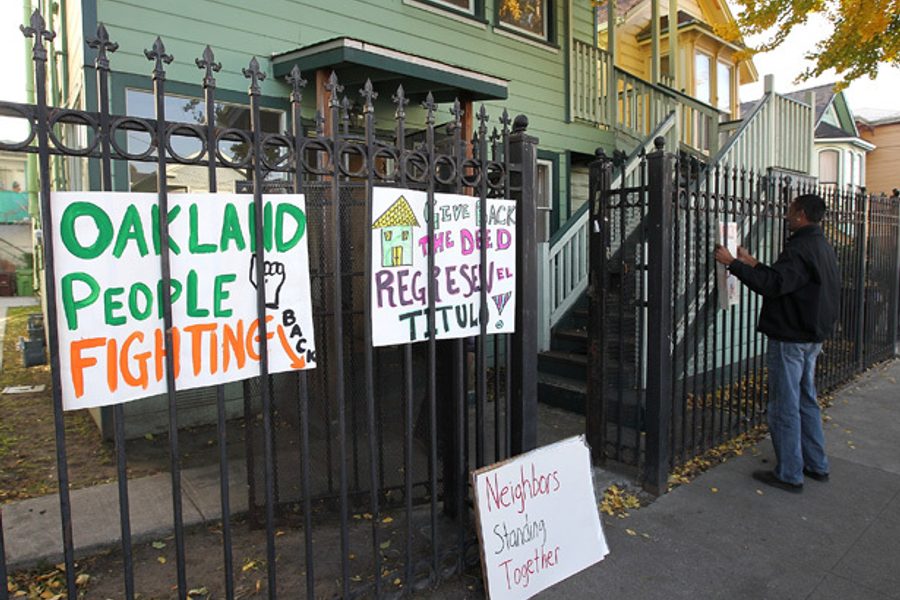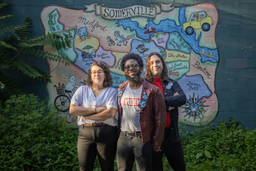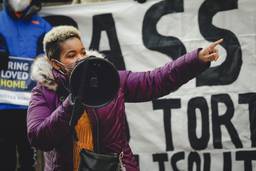
Police yesterday arrested nearly 80 Occupy San Francisco demonstrators who had less than 24 hours before taken over a building belonging to the Catholic Archdiocese of San Francisco.
According to the San Francisco Chronicle, police officers in riot gear stormed the building at about 1:15 p.m. on Monday after removing the plywood and stacks of chairs that had been used to block the doors. Though police forwarded photos of stockpiled bricks to the press and said in a statement that “there was concern that these items were going to be used as weapons against police officers,” occupiers did not throw anything at the police. Instead, according to police accounts, some of the building’s occupants retreated into barricaded rooms, while others locked themselves on the second floor. One protestor jumped from the roof and was arrested on the ground.
The OccupySF Commune, an offshoot of Occupy San Francisco, said that it had planned to convert the building into a community center. Though George Wesolek, a spokesman for the archdiocese, told the Chronicle that the building, 888 Turk, had been used for music classes as recently as 18 months ago, Occupy SF claims that the building had been vacant for five years. During this time, according to the movement, its owners have failed to register it as such, thereby avoiding paying vacancy fees.
Susie Cagle, a Bay Area journalist and graphic artist, described the scene that unfolded in an article for Truthout today:
Occupiers first took the building around 5:45 PM on Sunday, April 1, following a march of several hundred from downtown. It was clear that activists had held the building for some time before opening it - assignment of rooms and a skeletal organizational structure were already in place, as were signage and literature. The police said they were “monitoring” the situation, but couldn’t do anything unless the Catholic Archdiocese of San Francisco filed a formal complaint of citizen’s arrest, asking for the occupiers’ removal - and they hadn’t.
The most tense moment that first night came when the police briefly held up the occupiers’ pizza delivery.
By the next morning, things had changed. The San Francisco police had declared the area a “crime scene” and were for the most part limiting access to the building for both people and supplies.
… At some point on Monday, police say, an Archdiocese representative also requested the San Francisco Police Department (SFPD) remove the protesters, and signed a citizens arrest for trespassing giving the agency the authority to do so. According to Kerfoot, occupiers inside the building were on the phone, planning to meet with the Archdiocese at 3 PM about the future of the building.
In a statement released prior to the raid of the building, OccupySF said:
In a city with ten thousand homeless people and thirty-two thousand vacant but habitable units, it is a crime against humanity that people are prevented from sleeping through the night as part of a political protest or as a basic human right. The city wants OccupySF and the homeless off the street – harassing, intimidating, and arresting us every night – so now we are inside creating a vibrant space for health, humanity, and free expression.
This building has been empty for five years and was previously a mental health clinic providing a valuable service to the community. Five years ago the Board of Supervisors cut the funding to this vital community center causing many people with mental illness to be put out on the street and become subject to arrest and harassment simply for now existing in these very same streets they were forced into. This funding cut was brought on by the international financial crisis caused by a corrupt banking system which profits off the backs of the 99%.
The practice of occupying vacant buildings for social centers has been adopted by the 15-M movement of “indignados,” Occupy’s Spanish counterpart, en masse. According to Spanish journalist Ter Garcia, 15-M has converted at least 50 empty buildings into social centers, using the crowded assemblies to organize the large groups of squatters necessary to take the buildings.
But though the Occupy movement has since the latter months of 2011 begun moving homeless families into foreclosed homes, attempts to occupy vacant buildings for non-residential purposes — such as Occupy Oakland’s January 28th “Move-in Day” Action — have thus far been met with a rapid police response.
According to Cagle, many of those participating in the OccupySF occupation had also participated in the Oakland action. Others were part of the activist group Homes Not Jails, which has been staging occupations of vacant buildings in San Francisco for more than 20 years.
Despite its short duration, many participants pronounced the occupation a success. “SFPD’s biggest mistake was letting us do this,” OccupySF Commune member Jesse Smith told Cagle. “It just proves to us and every other occupy in the country that this can be done.”

I hope you found this article important. Before you leave, I want to ask you to consider supporting our work with a donation. In These Times needs readers like you to help sustain our mission. We don’t depend on—or want—corporate advertising or deep-pocketed billionaires to fund our journalism. We’re supported by you, the reader, so we can focus on covering the issues that matter most to the progressive movement without fear or compromise.
Our work isn’t hidden behind a paywall because of people like you who support our journalism. We want to keep it that way. If you value the work we do and the movements we cover, please consider donating to In These Times.
Rebecca Burns is an In These Times contributing editor and award-winning investigative reporter. Her work has appeared in Bloomberg, the Chicago Reader, ProPublica, The Intercept, and USA Today. Follow her on Twitter @rejburns.




